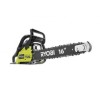Ryobi RY3716 Operation Manual - Page 21
Warning
 |
View all Ryobi RY3716 manuals
Add to My Manuals
Save this manual to your list of manuals |
Page 21 highlights
OPERATION WARNING: Closely check for broken or dead branches, which could fall while cutting and do not cut near buildings or electrical wires if you do not know the direction of tree fall. Do not cut at night or during bad weather conditions, such as rain, snow, or strong winds, which can reduce visibility and control of the chain saw. If the tree you are felling makes contact with any utility line, you should discontinue use of the chain saw and immediately notify the utility company. Failure to follow these instructions could result in death or serious personal injury. HINGE BACK CUT Fig. 22 When felling a tree, it is important that you heed the following warnings to prevent possible serious injury. ■n Do not cut down trees having an extreme lean or large trees with rotten limbs, loose bark, or hollow trunks. Have these trees pushed or dragged down with heavy equipment, then cut them up. ■n Do not cut trees near electrical wires or buildings. ■n Check the tree for damaged or dead branches that could fall and hit you during felling. ■n Periodically glance at the top of the tree during the backcut to assure the tree is going to fall in the desired direction. n If the tree starts to fall in the wrong direction, or if the saw gets caught or hung up during the fall, leave the saw and save yourself! Felling a tree - When bucking and felling operations are being performed by two or more persons, at the same time, the felling operation should be separated from the bucking operation by a distance of at least twice the height of the tree being felled. Trees should not be felled in a manner that would endanger any person, strike any utility line or cause any property damage. If the tree does make contact with any utility line, the utility company should be notified immediately. Before any cuts are started, pick your escape route (or routes in case the intended route is blocked); clear the immediate area around the tree and make sure there are no obstructions in WEDGE Fig. 23 your planned path of retreat. Clear paths of safe retreat should extend back and diagonally (45°) to the rear of the planned line of fall. When the tree begins to fall, you should retreat away from the direction of fall along a retreat path and at least 20 feet away from the trunk in case it kicks back over the stump. See Figure 20. Before felling is started, consider the force and direction of the wind, the lean and balance of the tree, and the location of large limbs. These things influence the direction in which the tree will fall. Do not try to fell a tree along a line different from its natural line of fall. The chain saw operator should keep on the uphill side of the terrain as the tree is likely to roll or slide downhill after it is felled. Remove dirt, stones, loose bark, nails, staples, and wire from the tree where felling cuts are to be made. Notched Undercut. Cut a notch about 1/3 the diameter of the tree as shown in figure 21. Make the cuts of the notch so they intersect at a right angle to the line of fall. This notch should be cleaned out to leave a straight line. To keep the weight of the wood off the saw, always make Page 21 - English















